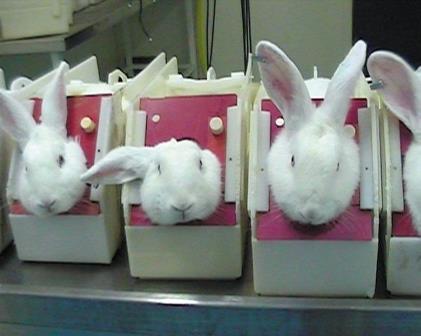What is animal testing?
An animal test is any scientific experiment or test in which a live animal is forced to undergo something that is likely to cause them pain, suffering, distress or lasting harm.
Animal experiments are not the same as taking your companion animal to the vet. Animals used in laboratories are deliberately harmed, not for their own good, and are usually killed at the end of the experiment.
Animal experiments
Animal experiments include:
-
injecting or force feeding animals with potentially harmful substances
-
exposing animals to radiation
-
surgically removing animals’ organs or tissues to deliberately cause damage
-
forcing animals to inhale toxic gases
-
subjecting animals to frightening situations to create anxiety and depression.
Animals used
Only vertebrate animals (mammals, birds, fish and amphibians) and some invertebrates such as octopuses are defined as ‘animals’ by European legislation governing animal experiments. Shockingly, in the USA rats, mice, fish, amphibians and birds are not defined as animals under animal experiments regulations. That means no legal permission to experiment on them is needed and they are not included in any statistics.
Animals used in experiments are usually bred for this purpose by the laboratory or in breeding facilities. It’s a cruel, multi-million dollar industry. Cruelty Free International believes that all animals are equally important. A dog bred for research is still a dog who could otherwise live a happy life in a loving home.
Some monkeys are still trapped in the wild in Africa, Asia and South America to be used in experiments or imprisoned in breeding facilities. Their children are exported to laboratories around the world. The use of wild-caught monkeys in experiments is generally banned in Europe but is allowed elsewhere.
Horses and other animals such as cows, sheep and pigs are often supplied by dealers and may originate from racing stables or farms for use in animal experiments. The rules preventing the use of stray companion animals like dogs and cats vary from country to country.
Animal suffering
A large proportion of animal experiments in the EU are reported to cause ‘moderate’ or ‘severe suffering’ to the animals - according to the researchers who carry them out. In the UK in 2018, 31% of animal experiments involved moderate or severe suffering.
Some experiments require the animal to die as part of the test. For example, regulatory tests for botox, vaccines and some tests for chemical safety are essentially variations of the cruel Lethal Dose 50 test in which 50% of the animals die or are killed very close to death.

The strength of botox is measured in mouse LD50 units. This cruel test involves injecting hundreds of mice directly into their abdomens and counting the number who die from poisoning over the next three days. Tens of thousands of mice suffer in this way in the UK and Ireland every year.
Laboratories
Laboratories are no place for any animal. They are typically sterile, indoor environments in which the animals are forced to live in cages – denied complete freedom of movement and control over their lives. Some animals in laboratories are confined on their own, without the companionship of others.

An animal test is any scientific experiment or test in which a live animal is forced to undergo something that is likely to cause them pain, suffering, distress or lasting harm.
The science relating to animal experiments can be extremely complicated and views often differ. What appears on this website represents Cruelty Free International expert opinion, based on a thorough assessment of the evidence.



